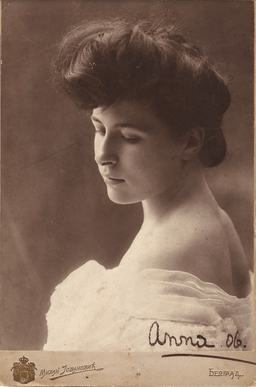Ana Marinković facts for kids
Quick facts for kids
Ana Marinković
|
|
|---|---|
| Ана Лозанић Маринковић | |

Lozanić, circa 1903-1904 by Milan Jovanović
|
|
| Born |
Ana Lozanić
7 April 1881 |
| Died | 30 May 1973 (aged 92) Guéthary, France
|
| Nationality | Serbian |
| Occupation | nurse, artist |
| Years active | 1908–1973 |
Ana Marinković (Serbian Cyrillic: Ана Маринковић) was a talented Serbian artist. She was born in Belgrade, Kingdom of Serbia, on April 7, 1881. She became well-known for her paintings from the early 1900s until World War II. Her artworks are now kept in important museums, including the Belgrade City Museum and the National Museum of Serbia. She passed away in Guéthary, France, on May 30, 1973.
Contents
Ana Marinković's Early Life
Ana Lozanić was born on April 7, 1881, in Belgrade. Her parents were Stanka Pačić and Sima Lozanić. Her father was a famous chemist and a professor. He was also the head of the University of Belgrade for a time. He even led the Serbian Royal Academy and worked in the Serbian government.
Ana was the middle child of three. She had an older brother named Milivoje and a younger sister named Jelena.
Becoming an Artist
Ana finished her schooling in Belgrade. There, she started studying art with a famous painter named Nadežda Petrović. She also took private art lessons from Rista and Beta Vukanović.
Later, she traveled to London and Paris to continue her art studies. In 1908, she had her first art show. People really liked her paintings, and she received good reviews from magazines. Before 1910, she married Vojislav Marinković, who was an economist and politician in Serbia.
Ana Marinković's Art Career
In 1910, Ana Marinković was asked to show her art with the Lada Art Society. This was a group of artists started by her teachers, the Vukanovićs. She became a full member of the society in 1911.
Helping During Wars
When the Balkan Wars began in 1912, Ana became a volunteer nurse. She joined her art teachers, Petrović and Vukanović, in the Army Medical Corps. During World War I, she helped care for wounded soldiers. She even went with her patients during the difficult Albanian retreat across the Prokletije Mountains. She helped them safely reach Corfu. Another painter, Kosta Miličević, was also with the Medical Corps. His style of painting, called Impressionism, later influenced Ana's art.
Founding Art Groups
In 1919, Ana Marinković helped start the Association of Fine Artists of Serbia (ULUS). Around the same time, she also helped create the Cvijeta Zuzorić Association. Both groups aimed to support and promote art in Belgrade.
Her paintings were shown in big exhibitions. In 1922, her work was part of the Fifth South Slav Exhibition in Belgrade. She was considered one of the "Belgrade Impressionists," along with other artists like Ljubomir Ivanović and Kosta Miličević. Before World War II, she also had major art shows in Turin, Italy, and Sofia, Bulgaria.
Later Life and Art
Because her family was wealthy, Ana didn't need to teach art to make a living. This allowed her to paint many different subjects, like still-life scenes, interiors of homes, and landscapes. She often painted the areas around Belgrade. She also volunteered with Queen Marija Karađorđević to help women and children in need.
In 1935, Ana faced several personal losses. Her father, Sima Lozanić, passed away in July. Her husband, Vojislav Marinković, died in September. And her brother-in-law, John Frothingham, also passed away in November.
During World War II, when the Nazis occupied Belgrade, Ana lived a quiet life. After the war, when new leaders came to power, she decided to leave Serbia. She moved to Guéthary, a town on the coast of France, where her sister had an orphanage. She continued to paint landscapes there until the 1970s. Near the end of her life, she gave some of her valuable paintings by Paja Jovanović and Kosta Miličević to the National Museum of Serbia.
Ana Marinković's Death and Legacy
Ana Marinković passed away on May 30, 1973, in Guéthary, France. Her paintings are part of the permanent collections in several important museums. These include the Belgrade City Museum, the Museum of Contemporary Art in Belgrade, and the National Museum of Serbia.
Some of her artworks are displayed alongside those of other women artists who volunteered with the Serbian Red Cross, like Zora Petrović and Nadežda Petrović. Their art often shares similar styles, with strong colors and emotional themes.
See also
- List of painters from Serbia
- War artist

